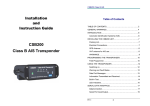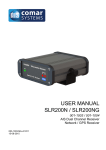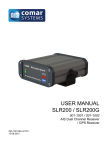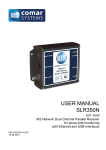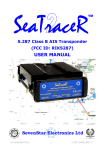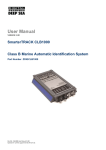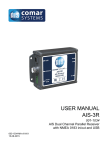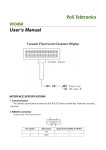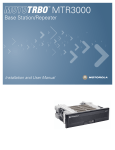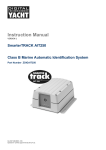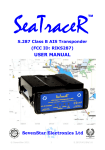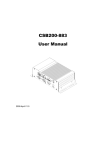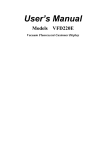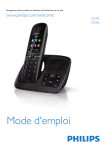Download Installation & Operating Manual
Transcript
USER MANUAL CSB200 001-1010 Class B AIS Transponder with NMEA 0183 / RS232 / RS422 Interfaces 003-1010-MA-v01r01 15-08-2015 CSB200 CONTENTS 1 INTRODUCTION ................................................................................. 4 1.1 1.2 Background to AIS ........................................................................................ 4 AIS Classes .................................................................................................. 4 2 CONTENTS OF THE BOX .................................................................. 5 3 INSTALLATION ................................................................................... 5 3.1 3.2 3.3 3.4 4 PROGRAMMING THE TRANSPONDER ............................................ 7 4.1 4.2 4.3 4.4 4.5 5 Mounting ....................................................................................................... 5 Power Connection ........................................................................................ 5 GPS Antenna ................................................................................................ 6 VHF Antenna for AIS use ............................................................................. 6 Installing the application ............................................................................... 7 Connecting to your CSB200 ......................................................................... 7 proAIS2 pages............................................................................................... 8 Configuring your CSB200 ............................................................................. 8 Optional Configuration .................................................................................. 9 USING THE TRANSPONDER ........................................................... 11 5.1 5.2 5.3 5.4 5.5 5.6 5.7 5.8 Switching On............................................................................................... 11 Warning and Fault States ........................................................................... 11 Data Port Messages ................................................................................... 12 Information Transmitted and Received ....................................................... 12 Transmit Off Facility .................................................................................... 13 Data ............................................................................................................ 13 Built in Test ................................................................................................. 13 LED Indicators ............................................................................................ 14 6 MAINTENANCE ................................................................................ 15 7 SERIAL DATA INTERFACE .............................................................. 15 7.1 7.2 7.3 Data Connection ......................................................................................... 15 Connection to a PC..................................................................................... 15 Connection to a Plotter ............................................................................... 15 8 SPECIFICATION ............................................................................... 16 9 LICENCING ....................................................................................... 17 10 DECLARATION OF CONFORMITY .................................................. 17 11 FCC APPROVAL: WXVCSB200........................................................ 18 12 STANDARDS .................................................................................... 18 13 GENERAL WARNINGS ..................................................................... 19 14 LIMITED WARRANTY ....................................................................... 20 15 PRODUCT SUPPORT ...................................................................... 20 3 CSB200 1 1.1 INTRODUCTION Background to AIS How AIS Works The marine Automatic Identification System (AIS) is a location and vessel information reporting system. It allows vessels equipped with AIS to automatically and dynamically share and regularly update their position, speed, course and other information such as vessel identity with similarly equipped craft. Position is derived from a Global Navigation Satellite System (GNSS) network and communication between vessels is by Very High Frequency (VHF) digital transmissions. A sophisticated and automatic method of time sharing the radio channel is used to ensure that even where a large number of vessels are in one location, blocking of individual transmissions is minimised, any degradation of the expected position reporting interval is indicated to the user, and even if the unit suffers extreme channel overload conditions it will always recover to normal operation. 1.2 AIS Classes There are two classes of AIS unit fitted to vessels, Class A and Class B. In addition AIS base stations may be employed by the Coastguard, port authorities and other authorised bodies. AIS units acting as aids to navigation (AtoNs) can also be fitted to fixed and floating navigation markers such as channel markers and buoys. Class A units are a mandatory fit under the safety of life at sea (SOLAS) convention to vessels above 300 gross tons or which carry more than 11 passengers in International waters. Many other commercial vessels and some leisure craft also fit Class A units. Class B units are currently not a mandatory fit, but authorities in several parts of the world are considering this. Class B units are designed for fitting in vessels which do not fall into the mandatory Class A fit category. The CSB200 is a Class B unit 4 CSB200 2 CONTENTS OF THE BOX Before proceeding with the installation of the CSB200, check the contents of the box which should include: ● ● ● ● ● ● The CSB200 AIS Transponder Unit Power Cable PC 9-pin D Male to Female Programming Cable 9-pin D Male Plug with bare wire end Cable CSB200 Installation CD This Manual 3 INSTALLATION WARNING: Do not connect the CSB200 unit to a mains (line) AC electrical supply, as an electric shock or fire hazard could result. CAUTION: Do not connect the CSB200 unit to a DC supply exceeding 15.6V or reverse the supply polarity, damage to the unit may result. CAUTION: The CSB200 unit is designed for operation in the temperature range -25°C to +55°C. Do not install (or use) the CSB200 unit in environments which exceed this range. CAUTION: The CSB200 unit should be installed in a location where it is protected from water and spray. 3.1 Mounting The CSB200 can be mounted to a suitable bulkhead or shelf. Hint: 3.2 Select a location away from excessive heat sources, avoid high levels of vibration and shock. Power Connection Connect a 12V DC supply (9.6-15.6V) capable of supplying 2A peak to the DC power lead. Positive = RED Negative = BLACK The case of the unit is not isolated from the negative terminal of the supply and therefore it is recommended that the unit is not attached to metal parts of the vessel. 5 CSB200 3.3 GPS Antenna The GPS antenna used must be of the active type (i.e. it should incorporate an LNA) and be suitable for marine shipboard applications (index of protection, ruggedness, means of mounting, etc.). An antenna should be selected with a gain (in dB) depending on the length of cable between the antenna and the AIS unit; after subtraction of cable and connector losses, a minimum total gain of 25 dB should be available at the CSB200 unit GPS antenna connector. The GPS antenna to be used for AIS use must be a dedicated antenna, i.e. not shared with any other GPS receiver. Installation of the GPS antenna is critical for the performance of the built in GPS receiver which is used for timing of the transmitted time slots and for the supply of navigational information should the main navigational GPS fail. We strongly recommend that: 1. The GPS antenna is mounted in an elevated position and free of shadow effect from the ship’s superstructure. 2. The GPS antenna has a free view through 360 degrees with a vertical angle of 5 to 90 degrees above the horizon. 3. As the received GPS signal is very sensitive to noise and interference generated by other onboard transmitters, ensure that the GNSS antenna is placed as far away as possible from radar, Inmarsat and Iridium transmitters and ensure the GPS antenna is free from direct view of the radar and the Inmarsat beam. 4. It is important that the MF/HF and other VHF transmitter antennas are kept as far away as possible from the GNSS antenna. It is good practice never to install a GNSS antenna within a radius of 5 meters from these antennas. 3.4 VHF Antenna for AIS use The VHF antenna employed for AIS use: • Must be a dedicated antenna, i.e. not shared with any other VHF transmitter/receiver. • Must be suitable for marine shipboard applications (index of protection, ruggedness, means of mounting, etc.) • Should be omni-directional and vertically polarised with unity gain (0 dB) with a bandwidth sufficient to maintain VSWR <1.5 over the frequency range 156-163 MHz. As a minimum the 3 dB bandwidth must cover the two AIS channels and the DSC Channel. • Should be mounted with at least a two metre vertical separation distance from any other VHF antenna used for speech or DCS communication. 6 CSB200 4 PROGRAMMING THE TRANSPONDER The proAIS2 application allows you to configure and monitor the performance of your CSB200. proAIS2 is compatible with both Microsoft® Windows® and Intel based Apple® Mac OS X operating systems. The system requirements are as follows: • Microsoft® Windows® XP, Windows® Vista®, Windows 7 (including both 32 and 64 bit versions) • Mac OS X 10.5 / 10.6 (Intel based systems only) 4.1 Installing the application The application is installed from the CD provided with your CSB200 transceiver. Insert the CD into your PC or Mac and navigate to the ‘Windows’ or ‘OSX’ folder. Windows Double click the ‘setup.exe’ item to start the installation and follow the on screen instructions. OS X Double click the ‘proAIS2.dmg’ item to start the installation and follow the on screen instructions. 4.2 Connecting to your CSB200 1, Before launching the proAIS2 application connect your CSB200 to your PC or Mac using the 9 Pin Serial cable supplied or via a USB to Serial Convertor. You can now launch proAIS2 from the Windows® Start menu or the OS X Applications folder. 2, Select the serial port corresponding to your CSB200 from the drop down menu at the top left of the proAIS2 window, and click the ‘Connect’ button. 3, proAIS2 is now communicating with your CSB200 and will display any preconfigured vessel data in the ‘Configuration’ page. 7 CSB200 4.3 proAIS2 pages The proAIS2 application has a number of pages with specific functions: • The ‘Configuration’ page shows the current vessel information and CSB200 configuration. Vessel information and configuration can also be edited and saved to the CSB200. • The ‘GPS Status’ page shows the status and signal strength information for the AIS internal GPS receiver. • The ‘Other Vessels’ page shows a list of AIS targets currently being received by the CSB200. • The ‘Diagnostics’ page shows a range of information relating to operation of the CSB200 which may be useful during installation. • The ‘Serial Data’ page shows real time data from the CSB200 in NMEA0183 format and provides functions to record this data. 4.4 Configuring your CSB200 Important information for US Customers: There are specific laws in the USA regarding the configuration of AIS class B transceivers. If you are a US resident and intend to use your CSB200 in US waters, you should make sure that your retailer has configured your product prior to supplying it to you. If your CSB200 has not been pre-configured please contact your dealer for details of how to have it configured. WARNING: It is a violation of the rules of the Federal Communications Commission to input an MMSI that has not been properly assigned to the end user, or to otherwise input any inaccurate data in this device. 1, Select the ‘Configuration’ page to configure the vessel data that will be transmitted by your CSB200. 2, Enter your vessel’s name (20 characters maximum), Call sign (optional, 7 characters maximum) and MMSI number. An MMSI number is required for the CSB200 to operate. The MMSI configured in your CSB200 should be the same as that configured in any other radio equipment on board. If you do not have an MMSI number contact the relevant authority in your country for more information. Once programmed the MMSI number cannot be changed. 3, Select the vessel type most appropriate to your vessel from the drop down list. 4, Enter the dimensions of your vessel and the location of the GPS antenna in the ‘Ship’s Dimensions and GPS Antenna Location’ box. The dimensions should be entered in metres and rounded up to the nearest whole metre (1 foot is approximately 0.3 metres). 8 CSB200 5, Save the configuration to your CSB200 by clicking the ‘Write configuration’ button at the top right of the configuration page. Please read the warning message and check the MMSI number is correct before clicking the programme button. 6, Your CSB200 is now fully configured and ready for use. 4.5 Optional Configuration The Configuration page includes additional options for NMEA port baud rates and GPS data output. NMEA Baud Rate Configuration Your CSB200 has both NMEA0183 and RS232 data ports, named as NMEA 1 Port. Typically the NMEA 1 Port is connected to a chart plotter or other display and is configured to operate at 38,400 baud. This baud rate is required for AIS data transfer. Your CSB200 provides a multiplex function between the NMEA Input (Port 2) and the NMEA/RS232 Output. Any data provided to the NMEA Input will be multiplexed to the NMEA/RS232 Output along with AIS data. Typically the NMEA Input Port is configured to operate at 4800 baud for connection to a heading sensor or other NMEA0183 device. Refer to the user manual supplied with your CSB200 regarding wiring diagrams. The ‘Configure Baud Rates’ box allows the baud rates for the NMEA0183 ports to be adjusted independently if required. After making changes to the baud rate settings click the ‘Write configuration’ button to save these settings to your AIS transceiver. GPS Data Output Your CSB200 incorporates an internal GPS receiver and can be configured to output GPS position fix information via the NMEA0183/RS232 port. Check the GPS data sentences required in the ‘Output GPS Sentences’ box. After making changes to the GPS output settings click the ‘Write configuration’ button to save these settings to your CSB200. GPS Status Page The GPS status page shows the current GPS signal strength along with current GPS position fix information. Satellite signals shown in green are actively being used to calculate a position. If a position fix is not available then no position information will be displayed and the signal strength bars will be shown in blue. Other Vessels Page The other vessels page provides a list of all AIS vessels from which AIS position reports are being received. For each vessel the MMSI, Name, Call sign, AIS Class, Speed, Course, Latitude, Longitude, Range and Bearing are shown along with the age (in seconds) of the position report. It is possible to sort the displayed information by clicking on the column headings. This information is provided for installation and diagnostic purposes only and should not be relied upon for navigation. 9 CSB200 Diagnostics Page The diagnostics page provides a range of information about your CSB200 operation and status. This information may be useful during installation or when attempting to diagnose a potential issue with the operation of your CSB200. If your CSB200 is operating normally all items in the checklist at the top left of the page will show a green tick / check mark. Serial Data Page The serial data page shows all data output from your CSB200 in NMEA 0183 format. It is also possible to send NMEA0183 commands to the CSB200 if required for technical support or custom configuration. A facility to record the data to a file is provided by clicking the ‘Log to File’ button. Menu Bar The application menu bar includes the following functions and features: File Menu • Open log file - opens a previously recorded log file for review in proAIS2. • Save log file - start recording data received from the connected CSB200 to file. • Exit - exits the proAIS2 application. Options Menu • Alert on AIS transmission - a brief sound is output from your PC or Mac on each AIS transmission. Help Menu • About - shows proAIS2 application version and copyright information. 10 CSB200 5 USING THE TRANSPONDER 5.1 Switching On When the 12V DC supply is switched on the green ON LED will light and the other six LED’s visible on the front panel of the unit will illuminate twice for a period of one second on each illumination. The Status, Error, TX Off and TX LEDs will then go out. The green RX LED will flash when it is receiving data from other AIS units. When the internal GPS is locked the yellow LED will go out and the green Status Led will light; note that this process may take up to 30 minutes depending on the switch-on state of the GPS receiver. The red TX LED will flash momentarily every time the unit transmits. 5.2 Warning and Fault States If the unit has not been able to transmit a position report during the last expected two reporting intervals (i.e. the nominal reporting interval cannot be maintained for operational reasons such as a Message 23 quiet period, high channel load conditions, etc) the yellow LED will illuminate. This is a warning condition only and indicates that your vessels position is not currently being reported to other vessels. Reception of other vessels AIS information by the CSB200 is not affected. When the unit is able to commence reporting the yellow LED will go out. If a fault occurs the red Error LED will illuminate. This may illuminate briefly if the power supply is interrupted or if the VHF antenna characteristics are briefly affected. If the red Error LED illuminates continuously the unit should be assumed to be faulty and should either be switched off (power removed) or if this is not practical, any other vessel position information derived from the unit should not be used and it should also be assumed that the unit is not transmitting valid position information for your vessel. The unit should be examined by an authorised service agent at the earliest opportunity. More details on LED indications can be found in the Operation section of this manual. 11 CSB200 5.3 Data Port Messages The data port will output the following: • (At power-up) boot-loader and main application splash text screens including version numbers, and memory status • Details of relevant AIS transmissions received • Details of AIS transmissions sent • Details of channel management messages received • Alarm messages generated by the BIIT function The data port will accept the following inputs: • Programming information • Alarm acknowledgements See the ‘Data Interface’ section of this manual for more details of data port messages. When in operation an AIS unit: • Uses one of two VHF channels within the international marine band allocation (channel 87B; 161.975MHz, or channel 88B; 162.025MHz) to regularly transmit information such as the vessel position, Maritime Mobile Service Identity (MMSI), Name, Speed, Course, etc. • Receives similar information from other AIS equipped vessels within VHF range and outputs that information for use by an external display medium (AIS enabled chart plotter, PC using AIS enabled chart plotter software etc.) 5.4 Information Transmitted and Received A Class A unit will transmit its IMO number (if known), MMSI, Call Sign and Name, Length and Beam, Ship Type, Time, Course Over Ground (COG), Speed Over Ground (SOG), Heading, Navigational Status, Rate of Turn, Draught, Cargo Type, Destination and safety related messages via a short message service (SMS) facility. Message lengths are variable with static and voyage related information being transmitted less often. A Class B unit will transmit its MMSI, Call Sign and Name, Length and Beam, Ship Type, Time, Course Over Ground (COG), Speed Over Ground (SOG) and Heading. 12 CSB200 5.5 Transmit Off Facility The transmit off facility is provided in the event that you do not wish to disclose your position to other users or to conserve power when it is not necessary to transmit your position. The transmitter can be turned off by connecting a simple switch between the Blue core on pin 6 and the Green core on pin 5. Closing this switch will cause the Blue-TX off LED and the Yellow Timeout LED to light, the Green Status LED will extinguish. Opening the switch will resume transmissions. Reception of AIS data during this operation will not be effected. 5.6 Data The default baud rate of the data link is 38.4kBaud with 8 data bits, one stop bit and no parity. No handshaking is used. The data interface conforms to IEC 61162-1. The CSB200 outputs the following NMEA 0183 messages VDM, VDO, RMC, ACA, ACS, ALR, TXT and ACK. 5.7 Built in Test The CSB200 is equipped with Built In Integrity Testing (BIIT). BIIT tests run continuously or at appropriate intervals simultaneously with the standard functions of the equipment. The BIIT detects any failure or malfunction that will significantly reduce integrity or stop operation of the CSB200 unit. The tests include: • AIS TX malfunction (synthesiser not locked and TX time-out not exceeded) • Antenna VSWR exceeds limit • Rx channel 1 malfunction (synthesiser not locked) • Rx channel 2 malfunction (synthesiser not locked) • Internal GNSS not in use • No valid SOG information • No valid COG information • Background noise > -77dBm • GPS failure • VSWR exceeding the maximum allowed level • The input voltage is out of the specified range 13 CSB200 5.8 LED Indicators ON This is a green LED which indicates, when lit, that power has been connected correctly to the transponder. Status This is a green LED which indicates, when lit, that the transponder hardware has been configured, the operating software is present, the CPU has booted up, the application software is running and everything is correct. RX This is a green LED which indicates when flashing that the CSB200 is receiving data from other AIS transponders and is outputting this data as a VDM NMEA sentence on the output data ports. If the Green LED is on continuously the unit has not been programmed with its personalised data, it will still send received data to the output port but will not transmit. TX This is a red LED which flashes momentarily when the CSB200 transmits its own AIS data. Timeout This is a yellow LED which indicates when lit that the transmitter is prevented from transmitting. Reasons for this include the following: • The transponder’s internal GPS receiver is not operating or is not yet ready • The transponder was unable to transmit an AIS message due to the channel being already occupied, e.g. by transmissions from other AIS transponders, or the TX Off function is in operation Error This is a red LED which indicates when lit, one of the following status conditions is possible: • Transmitter lockout timer (1 second maximum) has operated • GPS is unable to gain lock after 30 minutes • VHF antenna VSWR is out of range • Power Supply is out of range • Background noise level is above the threshold level (-77dBm) TX Off This is a Blue LED which indicates that the remote TX Off switch has been operated to manually stop the CSB200 transmitting data. 14 CSB200 6 MAINTENANCE WARNING: Unauthorised opening of the CSB200 unit will invalidate the warranty. CAUTION: Avoid using chemical solvents to clean the CBS200; solvents may damage the case material. NOTE: The CSB200 contains no serviceable parts. Contact your local Dealer if the unit fails to function correctly. 7 SERIAL DATA INTERFACE 7.1 Data Connection If an external display unit is to be used to show other AIS units within range (such as a chart plotter, PC serial terminal or other display device) connect the user end of the data interface cable to the display device. Note that the software in the display device must be configured for AIS operation. There is a 9-way D-type female connector mounted at the rear of the CSB200. The standard wire ended data cable assembly provided mates with this connector. 9 pin D 1 2 3 4 5 6 7 8 9 7.2 Core Colour Brown Red Orange Yellow Green Blue Violet Grey Black Connection to a PC CSB200 2 - Red - TX Data 3 - Orange - RX Data 5 - Green - Ground 7.3 Function -NMEA Output (RS422) +RS232 Output +RS232 Input +NMEA Output (RS422) Ground TX Off Switch + Not Used +NMEA Input (RS422) -NMEA Input (RS422) PC 9 pin Serial Port 2 - RX Data 3 - Transmit Data 5 - Ground Connection to a Plotter CSB200 1 - Brown - NMEA Output B 4 - Yellow - NMEA Output A Plotter / Radar NMEA Input B - Return NMEA Input A - Positive 15 CSB200 8 SPECIFICATION Physical Dimensions: L190 x W128 x H50mm Weight: 600g Power Power Supply Range: 9.6 - 15.6 Volts DC Power Consumption: 4W Peak Power Rating: 2A Connectors Power VHF Antenna Connector - BNC GPS Antenna Connector - TNC Indicators On, TX, RX, Status, TX Timeout, Error, TX Off GPS Receiver (AIS internal) RS232 38.4k Baud bi-directional RS422 38.4k Baud bi-directional VHF Transceiver Transmitter x 1 Receiver x 2 One receiver time shared between AIS and DSC Frequency: 156.025 to 162.025 MHz in 25 kHz steps Output Power: 33dBm ± 1.5 dB Channel Bandwith: 25kHz Channel Step: 25kHz Modulation Modes: Bit Rate: 25kHz GMSK (AIS, TX and RX) 25kHz AFSK (DSC, RX only) 9600 b/s ±50 ppm (GMSK) 1200 b/s ±30 ppm (FSK) Sensitivity - 107dBm 25kHz (Message Error Rate 20%) Co-Channel 10dB RX Sensitivity: Adjacent Channel 70dB IMD 65dB Blocking 84dB Environmental IEC 60945 Operating Temperature: -25ºC to +55ºC 16 CSB200 9 LICENCING IMPORTANT: In most countries the operation of an AIS unit is included under the vessels marine VHF licence provisions. The vessel on to which the AIS unit is to installed must therefore possess a current VHF radiotelephone licence which lists the AIS system and the vessel Call Sign and MMSI number. Please contact the relevant authority in your country for more information. In accordance with a policy of continual development and product improvement the CSB200 hardware and software may be upgraded from time to time and future versions of the CSB200 may therefore not correspond exactly with this manual. When necessary upgrades to the product will be accompanied by updates or addenda to this manual. Please take time to read this manual carefully and to understand its contents fully so that you can install and operate your AIS system correctly. Information contained in this manual is liable to change without notice. Comar Systems Ltd disclaims any liability for consequences arising from omissions or inaccuracies in this manual and any other documentation provided with this product. 10 DECLARATION OF CONFORMITY Hereby, Comar Systems Ltd of Vittlefields Technology Centre, Forest Road, Newport, Isle of Wight, PO30 4LY, United Kingdom, declare that this CSB200 is in compliance with the essential requirements and other relevant provisions of Directive 1999/5/EC. This product carries the CE mark, notified body number and alert symbol as required by the R&TTE directive. This product is intended for sale in the following member states: Intended Country of Use: GB FR ES SE AT NL PT DK NO BE IT FI IE LU GR CH 17 CSB200 11 FCC APPROVAL: WXVCSB200 WARNING: It is a violation of the rules of the Federal Communications Commission to input an MMSI that has not been properly assigned to the end user, or to otherwise input any inaccurate data into this device. The MMSI and Static Data in this transponder must be configured by the vendor of the device or by an appropriately qualified person in the business of installing marine communications equipment on board vessels. In no event shall the entry of static data in to this Class B device be performed by the end user. Knowingly programming a Class B device with inaccurate static data, or causing a Class B AIS to be programmed with inaccurate static data, is prohibited. 12 STANDARDS This product complies to all the necessary standards under the European R&TTE directive for Article 3.1(a), 3.1(b), 3.2 and 3.3(e). The following standards have been followed in pursuance of this: IEC62287-1: 2006-03 Maritime navigation and radiocommunication equipment and systems - Class B shipborne equipment of the automatic identification system (AIS) - Part 1: Carrier-sense time division multiple access (CSTDMA) techniques IEC60945: 2002-08 Maritime navigation and radiocommunication equipment and systems - General requirements - Methods of testing and required test results IEC61162-1: Maritime navigation and radiocommunication equipment and systems - Digital interfaces - Part 1: Single talker and multiple listeners IEC61108-1: GLOBAL NAVIGATION SATELLITE SYSTEMS (GNSS) - Part 1: Global positioning system (GPS) - Receiver equipment Performance standards, methods of testing and required test results EN301 843-1v2.1: Electromagnetic compatibility and Radio spectrum Matters (ERM); Electromagnetic Compatibility (EMC) standard for marine radio equipment and services; Part 1: Common technical requirements EN50383: Basic standard for calculation and measurement of electromagnetic field strength and SAR related to human exposure from radio base stations and fixed terminal stations for wireless telecommunications system (110MHz-40GHz) EN60950-1: Information technology equipment - Safety - Part 1: General requirements 18 CSB200 13 GENERAL WARNINGS Comar Systems Ltd is not responsible for damages or injuries caused by your use of, or inability to use the CSB200 correctly. The CSB200 is intended for use only by persons trained in navigation and only as a navigational aid, not as the sole method of navigation. All marine Automatic Identification System (AIS) units utilise a satellite based system such as the Global Positioning Satellite (GPS) network or the Global Navigation Satellite System (GLONASS) network to determine position. The accuracy of these networks is variable and is affected by factors such as the antenna positioning, how many satellites are used to determine a position and how long satellite information has been received for. It is desirable wherever possible therefore to verify both your vessel’s AIS derived position data and other vessels AIS derived position data with visual or radar based observations. The compass safe distance of this unit is 1m or greater for 0.3° deviation. VHF Antenna Connection Connecting a badly mismatched VHF antenna, leaving the VHF antenna port disconnected, or shorting the VHF antenna port will activate the VSWR alarm, cause the unit to stop sending position reports or cause damage to the transponder. Radio Frequency Exposure To meet the requirements for Radio Frequency Exposure it is necessary to install the VHF antenna correctly and operate the AIS equipment according to the instructions. The VHF antenna must be mounted at a minimum distance (vertical separation) of 3 metres from the head of any person standing on deck in order to meet international safety directives on Maximum Permissible Exposure (MPE) / Specific Absorption Rate (SAR). Where no suitable structure exists to achieve a 3 metre vertical separation then the antenna base must be mounted at least 1 metre above the head of any person within range, all persons should stay outside the 3 metre safety radius and if practical, a grounded RF shield should be interposed between people and the antenna. Failure to adhere to these limits could expose persons within the 3 metre radius to RF radiation in excess of the MPE / SAR limits. 19 CSB200 14 LIMITED WARRANTY Comar Systems Ltd warrants this product to be free from defects in materials and manufacture for one year from the date of purchase. Comar Systems Ltd will, at its sole option, repair or replace any components that fail in normal use. Such repairs or replacement will be made at no charge to the customer for parts and labour. The customer is, however, responsible for any transportation costs incurred in returning the unit to Comar Systems Ltd. This warranty does not cover failures due to abuse, misuse, accident or unauthorised alteration or repairs. The above does not effect the statutory rights of the consumer. Note: Every effort has been made to ensure that all information contained in this manual is accurate at the time of going to press. We therefore cannot take any responsibility for the content of this manual and advise that you take normal steps to ensure that the information is at its most current when you are reading this manual. 15 PRODUCT SUPPORT Comar Systems Limited Vittlefields Technology Centre Forest Road Newport Isle of Wight, PO30 4LY United Kingdom Telephone: +44 (0) 1983 828900 E-mail: [email protected] Internet: www.comarsystems.com 20





















